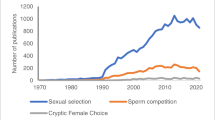Abstract
Is the gender disparity in sexual experience the same for men and women who are blind? Perhaps being impervious to visual cues would generate restrained sexual appetites in both genders. Our ethnographic findings suggest otherwise; the gender disparity persists even among men and women who are blind. The findings are discussed in terms of the cross-species research on multiple cues underlying mate selection, the combined utility of mate selection traits, and the physiological significance of sexual pleasure. Brief excerpts from our interviews are also included.
Similar content being viewed by others
References
Abramson, P.R.: Romance in the ivory tower: the rights and liberties of conscience. MIT Press, Cambridge (2007)
Abramson, P.R.: Sex appeal: six principles for the 21st century. Oxford University Press, New York (2010)
Abramson, P.R., Abramson, A.: Smells like teen spirit: the conundrum of kids, sex and the law. In: Coupet, S., Marrus, E. (eds.) Kids, sex and the law. NYU Press, New York (2013)
Abramson, P.R., Pinkerton, S.D.: With pleasure: thoughts on the nature of human sexuality. Oxford University Press, New York (1995)
Abramson, P.R., Pinkerton, S.D.: Sexual nature/sexual culture. University of Chicago Press, Chicago (1995)
Abramson, P.R., Pinkerton, S.D.: The handy-dandy kitchen device. Science 282, 1993 (1998)
Abramson, P.R., Pinkerton, S.D., Huppin, M.: Sexual rights in America: the ninth amendment and the pursuit of happiness. NYU Press, New York (2003)
Arnow, B.A., Desmond, J.E., Banner, L.L., Glover, G.H., Solomon, A., Polan, M.L., Lue, T.F., Atlas, S.W.: Brain activation and sexual arousal in healthy, heterosexual males. Brain 125, 1014–1034 (2002)
Barkow, J., Cosmides, L., Tooby, J.: The adapted mind: evolutionary psychology and the generation of culture. Oxford University Press, New York (1992)
Bateman, A.J.: Inter-sexual selection in Drosophilia. Heredity 2, 349–368 (1948)
Berdahl, A., Torney, C.J., Ioannou, C.C., Faria, J.J., Couzin, I.D.: Emergent sensing of complex environments by mobile animal groups. Science 339, 574–576 (2013)
Brennan, P.: Sexual selection. Nat. Educ. Knowl. 3, 79–85 (2012)
Buss, D. (ed.): The handbook of evolutionary psychology. Wiley, New York (2005)
Byers, J., Dunn, S.: Bateman in nature: predation on offspring reduces the potential for sexual selection. Science 338, 802–804 (2012)
Charles, R., Ritz, D.: Brother Ray: Ray Charles own story. Da Capo Press, New York (1978)
Conley, T.: Perceived proposer characteristics of gender differences in acceptance of casual sex offers. J. Pers. Soc. Psychol. 100, 309–329 (2011)
Candolin, U.: The use of multiple cues in mate choice. Biol. Rev. 78, 575–595 (2003)
Deutschlander, A., Stephan, A., Hufner, K., Wagner, J., Wiesmann, M., Strupp, M., Brandt, T., Janh, K.: Imagined locomotion in the blind: an fMRI study. Neuroimage 45, 122–128 (2009)
de Waal, Frans: Peacemaking among primates. Harvard University Press, Cambridge (1989)
de Waal, Frans: Our inner ape. Riverhead, New York (2005)
Fisher, R.A.: The general theory of natural selection. Clarendon Press, Oxford (1930)
Hull, E.M., Du, J., Lorrain, D.S., Matuszewich, L.: Extracellular dopamine in the medial preoptic area: implications for sexual motivation and hormonal control of copulation. J. Neurosci. 15, 7465–7471 (1995)
Johnstone, R.A.: The evolution of animal signals. In: Krebs, J.R., Davies, N.B. (eds.) Behavioral ecology: an evolutionary approach. Blackwell Science, Oxford (1997)
Laumann, E.O., Gagnon, J.H., Michael, R.T., Michaels, S.: The social organization of sexuality: sexual practices in the United States. University of Chicago Press, Chicago (1994)
LeVay, S.: The sexual brain. MIT Press, Cambridge (1993)
LeVay, S.: Gay, straight, and the reason why: the science of sexual orientation. Oxford University Press, New York (2011)
Lindstrom, K., Lindstrom, J.: Male greenfinches with brighter ornaments have higher virus infection clearance rate. Behav. Ecol. Sociobiol. 48, 44–51 (2000)
Moller, A.P., Pomankowski, A.: Why have birds got multiple sexual ornaments? Behav. Ecol. Sociobiol. 32, 167–176 (1993)
Meyer-Bahlburg, H.F.L.: Psychoneuroendocrinology and sexual pleasure. In: Abramson, P.R., Pinkerton, S.D. (eds.) Sexual nature/sexual culture. University of Chicago Press, Chicago (1995)
Reardon, S.: Playing by ear. Science 333, 1816–1818 (2011)
Renier, L., Anurova, I., De Volder, A.G., Carlson, S., VanMeter, J., Rauschecker, J.P.: Preserved functional specialization for spatial processing in the middle occipital gyrus of the early blind. Neuron 68, 138–148 (2010)
Rowe, C.: Receiver psychology and the evolution of multi-component signals. Anim. Behav. 58, 921–931 (1999)
Scheuber, H., Jacot, A., Brinkhof, M.W.G.: Female preference for multiple condition-dependent components of a sexually selected signal. Proc. R. Soc. Lond. B 271, 2453–2457 (2004)
Shakespeare, T.: Disabled sexuality: toward rights and recognition. Sex. Disabil. 18, 159–166 (2000)
Shakespeare, T., Gillespie-Sells, K., Davis, D.: The sexual politics of disability. Cassell, London (1996)
Symons, D.: The evolution of human sexuality. Oxford University Press, New York (1979)
Symons, D.: Beauty is in the adaptations of the beholder: the evolutionary psychology of human female sexual attractiveness. In: Abramson, P.R., Pinkerton, S.D. (eds.) Sexual nature/sexual culture. University of Chicago Press, Chicago (1995)
Trivers, R.: The folly of fools. Basic, New York (2011)
Uetz, G.W., Roberts, J.A.: Multisensory cues and multimodel communication in spiders: insights from video/audio playback studies. Brain Behav. Evol. 59, 222–230 (2002)
Van Maanen, J.: Tales of the field. University of Chicago Press, Chicago (1988)
Wallen, K.: The evolution of female sexual desire. In: Abramson, P.R., Pinkerton, S.D. (eds.) Sexual nature/sexual culture. University of Chicago Press, Chicago (1995)
Wedekind, C.: Detailed information about parasites revealed by sexual ornamentation. Proc. R. Soc. Lond. Ser. B 247, 169–174 (1992)
Wilson, J.: Sex hormones and sexual behavior. In: Abramson, P.R., Pinkerton, S.D. (eds.) Sexual nature/sexual culture. University of Chicago Press, Chicago (1995)
Acknowledgments
The authors wish to thank the UCLA Undergraduate Sex is Blind Research Team for helping to get this project off the ground. The members include Elaine Codd, Amelia Evert, Paymon Jalali, Veronika Meier, Tyler Rudin, and Diana Wang. The authors also wish to thank Don Symons, Bianca Acevedo, Andrew Christensen and Terri Conley for their comments on the manuscript.
Author information
Authors and Affiliations
Corresponding author
Rights and permissions
About this article
Cite this article
Abramson, P.R., Boggs, R. & Jolie Mason, E. Sex is Blind: Some Preliminary Theoretical Formulations. Sex Disabil 31, 393–402 (2013). https://doi.org/10.1007/s11195-013-9313-9
Published:
Issue Date:
DOI: https://doi.org/10.1007/s11195-013-9313-9




